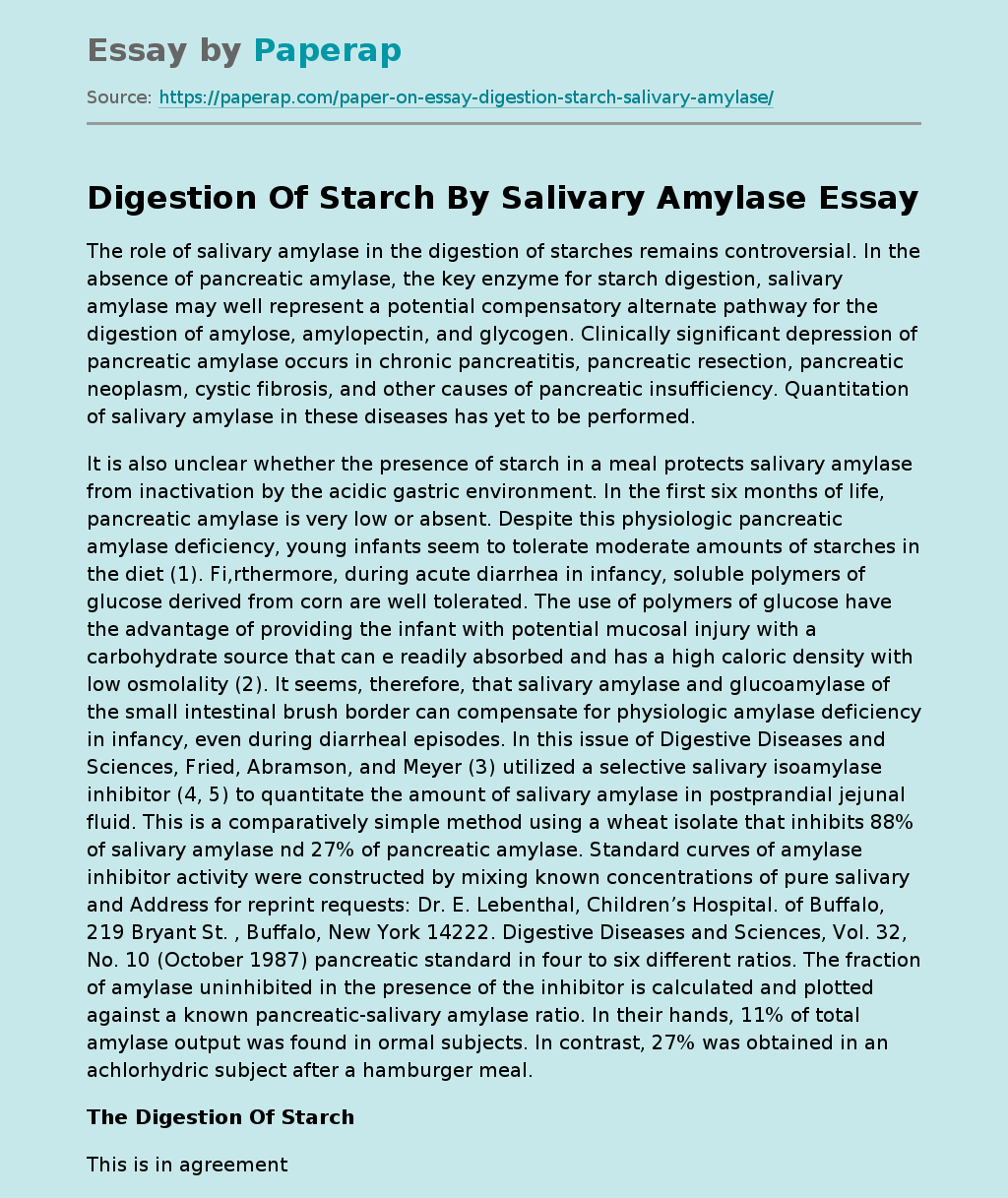Digestion Of Starch By Salivary Amylase
The role of salivary amylase in the digestion of starches remains controversial. In the absence of pancreatic amylase, the key enzyme for starch digestion, salivary amylase may well represent a potential compensatory alternate pathway for the digestion of amylose, amylopectin, and glycogen. Clinically significant depression of pancreatic amylase occurs in chronic pancreatitis, pancreatic resection, pancreatic neoplasm, cystic fibrosis, and other causes of pancreatic insufficiency. Quantitation of salivary amylase in these diseases has yet to be performed. It is also unclear whether the presence of starch in a meal protects salivary amylase from inactivation by the acidic gastric environment.
In the first six months of life, pancreatic amylase is very low or absent. Despite this physiologic pancreatic amylase deficiency, young infants seem to tolerate moderate amounts of starches in the diet. Fi,rthermore, during acute diarrhea in infancy, soluble polymers of glucose derived from corn are well tolerated. The use of polymers of glucose have the advantage of providing the infant with potential mucosal injury with a carbohydrate source that can e readily absorbed and has a high caloric density with low osmolality.
It seems, therefore, that salivary amylase and glucoamylase of the small intestinal brush border can compensate for physiologic amylase deficiency in infancy, even during diarrheal episodes.
In this issue of Digestive Diseases and Sciences, Fried, Abramson, and Meyer utilized a selective salivary isoamylase inhibitor to quantitate the amount of salivary amylase in postprandial jejunal fluid. This is a comparatively simple method using a wheat isolate that inhibits 88% of salivary amylase nd 27% of pancreatic amylase.
Standard curves of amylase inhibitor activity were constructed by mixing known concentrations of pure salivary and Address for reprint requests: Dr. E. Lebenthal, Children’s Hospital. of Buffalo, 219 Bryant St. , Buffalo, New York 14222. Digestive Diseases and Sciences, Vol. 32, No. 10 pancreatic standard in four to six different ratios. The fraction of amylase uninhibited in the presence of the inhibitor is calculated and plotted against a known pancreatic-salivary amylase ratio. In their hands, 11% of total amylase output was found in ormal subjects.
In contrast, 27% was obtained in an achlorhydric subject after a hamburger meal. This is in agreement with previous work by Skude and Ihse. When gastric pH is below 3. 0, however, salivary amylase is not detected in the stomach. Malagelada et al demonstrated that after a steak sandwich the gastric pH is >3. 0 for 60 min. Since the stomach will have emptied a substantial portion of its contents by that time, a significant amount of amylase could pass through the stomach without inactivation. It will be interesting to etermine whether starch alone will protect salivary amylase for inactivation in the stomach without the buffering capacity of other components of a meal; glucose polymers have been known to show some protective effect.
Although the amylases found in saliva and pancreatic secretion in humans are similar immunologically, they have distinct characteristics in their structure, function, and genetics. Salivary amylase is controlled by the Amy 1 locus of the chromosome, while pancreatic amylase is controlled by the Amy 2 locus, which is distinctly different from the Amy 1 locus. Salivary amylase nd pancreatic amylases differ from one another by several properties and can be separated by ionexchange chromatography or polyacrylamide gel electrophoresis and isoelectric focusing. The salivary and pancreatic amylases are similar in molecular weight (1 and amino acid composition. The two isoenzymes are further distinguishable in their sensitivity to selective inhibitors, particularly an isolate from wheat which inhibits salivary amylase to a higher degree than pancreatic amylase. Last but not least, salivary and pancreatic amylase diff
Digestion Of Starch By Salivary Amylase. (2019, Dec 05). Retrieved from https://paperap.com/paper-on-essay-digestion-starch-salivary-amylase/

